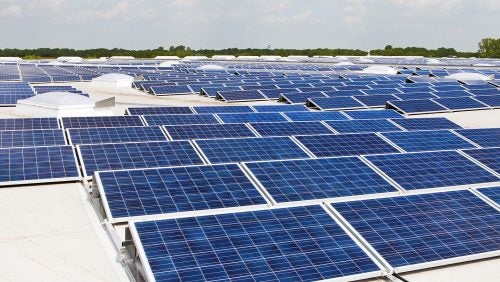Community Solar: A Solution to Solar Problems with Significant Legal Barriers
April 2, 2020 by Linn Bumpers

Community solar is a widespread solution for those who cannot invest in rooftop solar but want renewable energy. How does this innovative energy system fit into the existing legal frameworks?
There is a growing demand for solar power in the United States. However, despite the rapid growth of solar in the last decade, less than 16 percent of Americans have the ability to invest in the traditional rooftop solar model.[1] The concept of community solar has emerged to provide customers access to solar energy without installing rooftop panels by allowing participants to buy in to an off-site solar array, and crediting them with the value of the energy produced. Community solar is a relatively new and emerging concept that only began in 2010. However, over the last decade it has grown rapidly—40 states have hosted some type of community solar and 19 have enacted community solar policies.[2] The concept continues to grow with 1,523 Megawatts of community solar being installed in 2018 alone.[3] However, community solar is restricted by existing legal frameworks, and faces two major roadblocks.
First, community solar requires state enabling laws to function. By investing in the installation of off-site solar panels, or by leasing the energy of off-site solar panels from a single investor, a participant in community solar will receive a credit for the amount of energy generated by their panels.[4] This credit is typically applied to the participants energy bill, and the energy their panel produced is subtracted from their total energy used. This concept of “virtual net metering” however, requires state legislation.[5] The need for state action on authorizing virtual net metering is one of the biggest barriers to community solar.
Second, community solar projects can run into issues under security laws and regulations. Federal and state securities laws are intended to protect small investors from fraudulent promotions. Depending on the model that is used, selling shares in community solar projects may implicate federal and state securities laws. Although the federal statutes do not clearly define what a security is, in S.E.C. v. W.J. Howey Co., the Supreme Court articulated that a security is any transaction that involves an investment of capital with an expectation of profits without effort on the part of the investor.[6] Whether a community solar project would be a “security” is under this definition is still not clear.[7] There has been scholarly discussion regarding whether community solar projects may fall under securities regulation, with some authors claiming that all CSPs involve the sale or offer of securities and others explaining that bill-crediting relieves a CSP any securities liability.[8] Generally, to be safe under income tax laws and to potentially be safe under securities laws, the best practices for CSP administrators to use seems to be bill-crediting to ensure that subscribers are not viewed as ‘investors’ and that energy bill savings are not considered income. Through this model, the CSP agreement looks more like the customer paying for the energy ahead of time and subsequently receiving a credit. Regardless, state securities law also vary and it would be smart for any potential CSP administrator to take a deeper dive into the federal and state securities laws as applied to his project and whether it falls into one of the potential exceptions.[9]
[1] Joyce McLaren, Community Shared Solar, Policy and Regulatory Considerations, Nat’l Renewable Energy Laboratory (2014). Available at https://www.nrel.gov/docs/fy14osti/62367.pdf
[2] Sarah Johnson Phillips & Sara Bergan, Community Solar Ready for the new Decade, Power Mag, (2020). Available at https://www.powermag.com/community-solar-ready-for-the-new-decade/
[3] Id.
[4] McLaren Supra Note 1.
[5] Utility-owned community solar systems do not require state enabling statutes, but often do not pass the same benefits to the participant.
[6] S.E.C. v. W.J. Howey Co., 328 U.S. 293 (1946)
[7] Kristin L. Bailey, Insecurity for Community Solar: Three Strategies to Confront an Emerging Tension Between Renewable Energy Investment and Federal Securities Laws, 10 J. Telecomm. & High Tech. L. 123 (2012). Available at https://1.next.westlaw.com/Link/Document/FullText?findType=Y&serNum=0370296414&pubNum=0167350&originatingDoc=NE7126A21A82911E99F30F2A7AC07F1C8&refType=LR&originationContext=document&transitionType=DocumentItem&contextData=(sc.Search)&firstPage=true&bhcp=1&CobaltRefresh=54316
[8] Id.; Energysage, Virtual Net Metering: What is It? How Does It Work? (2016). Available at http://news.energysage.com/virtual-net-metering-what-is-it-how-does-it-work/; Sara E. Beran, Andrew P. Moratzka, Brian Orion, Sarah Johnson Phillips, David T. Quinby, The Law of Solar: Sommunity Solar, Stoel Rives (2017) Ch. 9 Pg. 5-6.
[9] Beran et al. supra note 8.

